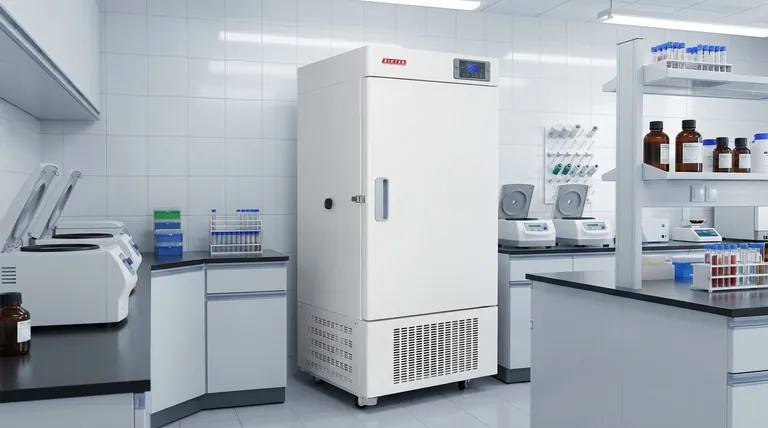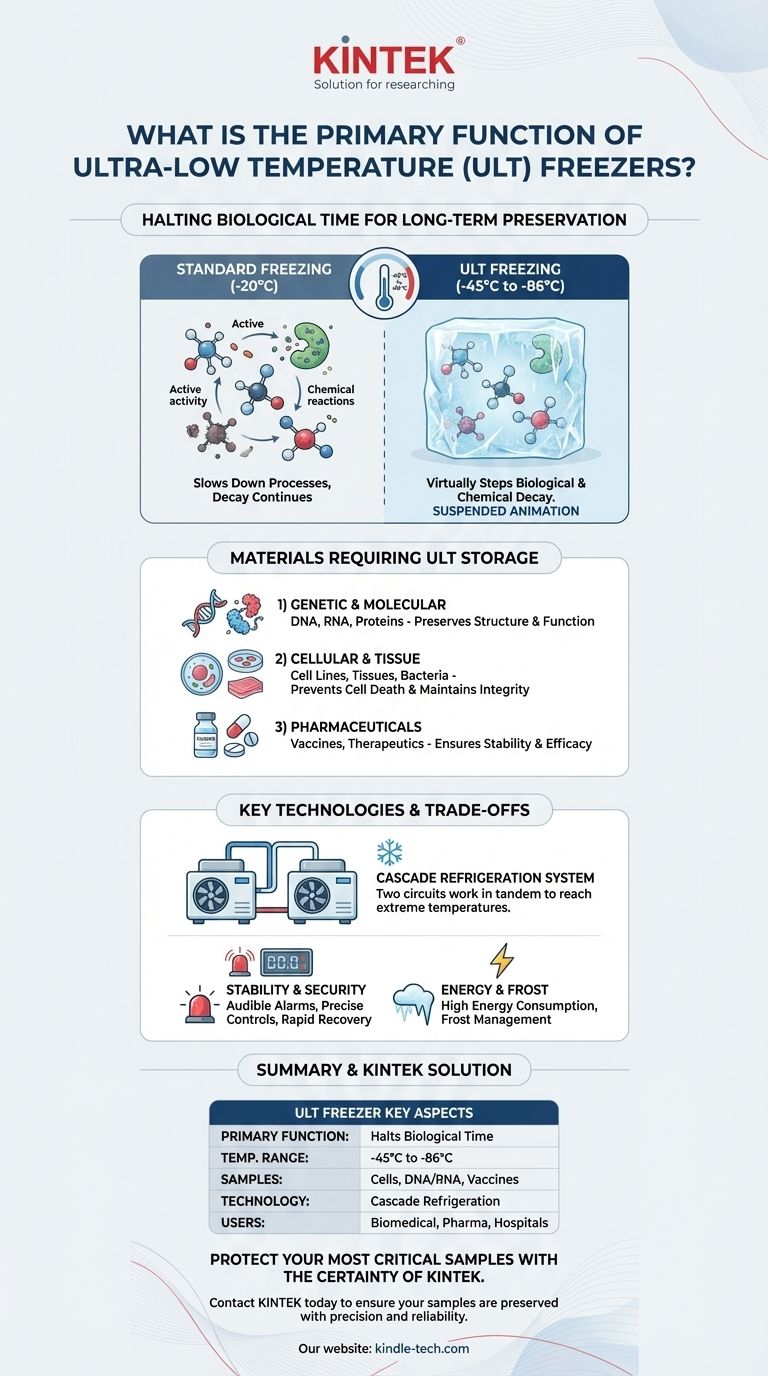At its core, the primary function of an ultra-low temperature (ULT) freezer is to effectively halt biological time for sensitive samples. These specialized units create an environment so cold—typically between -45°C and -86°C—that the chemical and enzymatic processes responsible for degradation virtually stop. This allows for the long-term preservation of invaluable biological materials like cells, tissues, proteins, and vaccines.
A ULT freezer's purpose extends beyond simple cold storage. Its function is to induce a state of suspended animation at a molecular level, ensuring that a sample's biological integrity remains unchanged from the moment it was frozen, whether it's stored for one year or several decades.

The Principle: Halting Biological and Chemical Decay
To understand the necessity of a ULT freezer, we must first understand why standard freezing is insufficient for scientific and medical applications.
Why Standard Freezing Isn't Enough
A household or standard laboratory freezer, operating around -20°C, significantly slows down biological processes. However, it does not stop them entirely.
Over time, residual enzymatic activity and slow chemical reactions will still degrade complex molecules like DNA, RNA, and proteins, rendering them useless for sensitive research or clinical use.
The Critical Temperature Threshold
ULT freezers operate below the critical temperature point of approximately -40°C. In the range of -45°C to -86°C, virtually all metabolic activity ceases.
This extreme cold locks molecules in place, preventing the degradation, denaturation, or destruction that would otherwise occur. This is the key to achieving reliable, long-term sample preservation.
Who Relies on This Technology?
The ability to preserve samples for extended periods is crucial across numerous fields. ULT freezers are indispensable in biomedical research, hospitals, pharmaceutical development, blood banks, and forensic labs.
They enable long-term genetic studies, the storage of cell lines for drug discovery, and the stockpiling of vaccines for public health initiatives.
What Materials Require Ultra-Low Temperatures?
The need for a ULT freezer is dictated by the molecular fragility of the sample being stored. Not all materials require this level of preservation.
Genetic and Molecular Components
Samples like DNA, RNA, and proteins are highly complex molecules. Their specific three-dimensional structures are essential to their function. The extreme cold of a ULT freezer is necessary to preserve these structures and prevent enzymatic breakdown.
Cellular and Tissue Samples
For materials like cell lines, tissues, and bacteria, the goal is to prevent cell death and maintain structural integrity. Ultra-low temperatures are required to stop all metabolic processes without causing damage from ice crystal formation, ensuring the samples are viable for future cultures or analysis.
High-Value Pharmaceutical Products
Many modern vaccines and therapeutic drugs are biologically based. Their efficacy depends on maintaining the stability of their active ingredients. ULT freezers provide the stable, intensely cold environment required to guarantee their potency from production to administration.
Understanding the Trade-offs and Key Technologies
While essential, ULT freezers are complex machines with specific operational principles and challenges that users must understand.
The Role of Cascade Refrigeration
Unlike a standard freezer that uses a single compressor, a ULT freezer relies on a cascade refrigeration system. This involves two separate cooling circuits working in tandem.
The first circuit cools the second, allowing the second circuit to reach a much lower temperature than a single system ever could. This is the core technology that enables temperatures of -86°C.
The Demand for Stability and Security
The value of the samples stored means that temperature fluctuations are unacceptable. Key features like audible and visual alarms, rapid temperature recovery after door openings, and precise digital controls are not luxuries—they are essential for protecting irreplaceable work.
The Challenge of Energy and Frost
The primary trade-off of a ULT freezer is its high energy consumption. Maintaining such extreme temperatures is an energy-intensive process.
Furthermore, any introduction of moist, ambient air will immediately create frost, which acts as an insulator and reduces the freezer's efficiency. This makes features like heated door seals and pressure release valves critical for long-term performance.
Making the Right Choice for Your Goal
Selecting a ULT freezer depends entirely on the intended application and the value of the samples being stored.
- If your primary focus is long-term biobanking: You need a model with maximum temperature stability, uniformity, and robust security features like backup systems and remote monitoring.
- If your primary focus is daily-access clinical research: Prioritize a unit with rapid temperature recovery after frequent door openings to protect all samples inside.
- If your primary focus is pharmaceutical GMP storage: You require a freezer with strict temperature validation capabilities, data logging, and F-gas compliance to meet regulatory standards.
Ultimately, a ULT freezer is an investment in the certainty and reproducibility of scientific and medical discovery.
Summary Table:
| Key Aspect | Description |
|---|---|
| Primary Function | Halts biological time by stopping enzymatic/metabolic activity for long-term preservation. |
| Typical Temperature Range | -45°C to -86°C |
| Common Samples Stored | Cells, tissues, proteins, DNA/RNA, vaccines, pharmaceuticals. |
| Core Technology | Cascade refrigeration system with two cooling circuits. |
| Primary Users | Biomedical research labs, hospitals, pharmaceutical companies, blood banks. |
Protect your most critical samples with the certainty of KINTEK.
Choosing the right ultra-low temperature freezer is vital for the integrity of your research, clinical diagnostics, or biopharmaceutical storage. KINTEK specializes in providing reliable lab equipment, including ULT freezers, designed to meet the rigorous demands of laboratory preservation. Our solutions ensure temperature stability, security, and compliance to safeguard your invaluable work.
Let our experts help you select the ideal ULT freezer for your specific application—whether it's for long-term biobanking, daily clinical access, or GMP storage.
Contact KINTEK today to ensure your samples are preserved with precision and reliability.
Visual Guide

Related Products
- 108L Vertical Ultra Low Temperature ULT Freezer
- 408L Advanced Vertical Laboratory Ultra Low Temperature Freezer for Critical Research Material Preservation
- 708L Ultra Low Temperature Freezer High Performance Laboratory Freezer
- 208L Advanced Precision Laboratory Ultra Low Temperature Freezer for Cold Storage
- 608L Essential Laboratory Ultra Low Temperature Freezer For Critical Sample Preservation
People Also Ask
- How do Ultra-Low Temperature freezers ensure the integrity of microbiological samples? Maintain Stability for Critical Research
- What advantages do ultra-low temperature freezers offer? Ensure Long-Term Sample Integrity and Reliability
- What are ultra low temperature freezers used for? Preserving Critical Biological Samples for Decades
- Where are ultra low temperature freezers commonly used? Essential for Labs, Hospitals, and Biotech
- What are the common designs of ultra-low temperature freezers? Upright vs. Chest Models for Your Lab



















